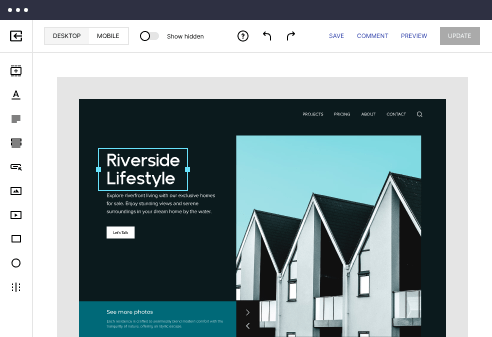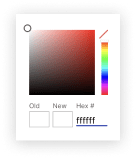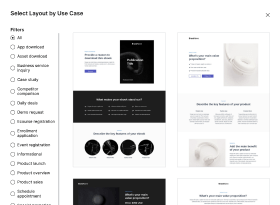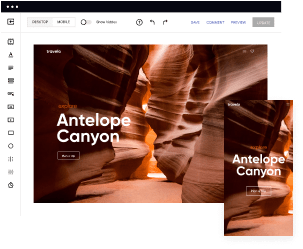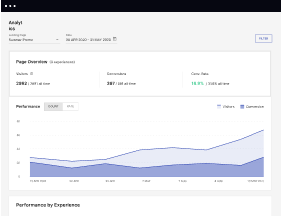Get a starting point with the Angular.js optimized feed page template
Supercharge your feed page with Angular.js for outstanding performance! Learn more today.
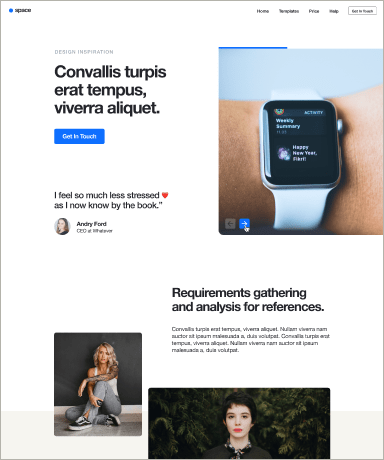
Easy to build without coding
With the intuitive drag-and-drop builder, anyone on your team can create high-converting pages without any knowledge of code or design. Make enhancements to your landing page with custom widgets using Javascript, HTML/CSS, or third-party scripts.
Multiple layouts for any industry and goal
Select from 500+ landing page layouts built to boost conversions across industry-specific scenarios. Customize them by adjusting fonts, adding images, and generating on-brand content with the AI assistant. Quickly scale with Instablocks® and Global Blocks that you can save, reuse, and update globally.
Loads fast and looks polished on any device
Every template is responsive, which means they present professionally on any device and load blazingly fast with our Thor Render Engine. You can also power them up with Google AMP technology to deliver an unparalleled mobile experience and drive higher conversions.
Robust analytics & experimentation
Get real-time updates and reporting across all your devices, showing the number of visitors, conversions, cost-per-visitor, and cost-per-lead. Launch AI-powered experiments, run A/B tests, and use heatmaps to analyze user behavior, then optimize your landing page to maximize conversions.

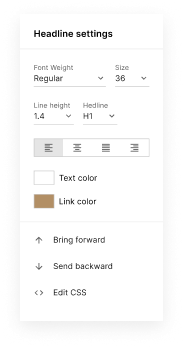
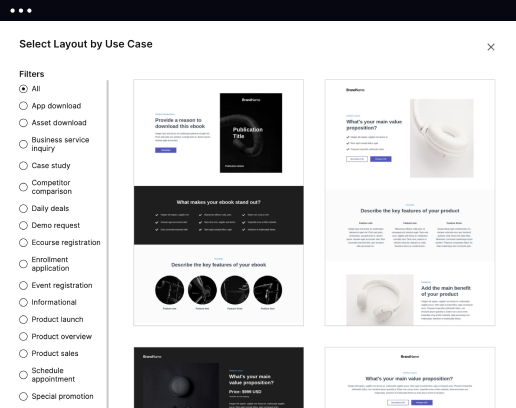
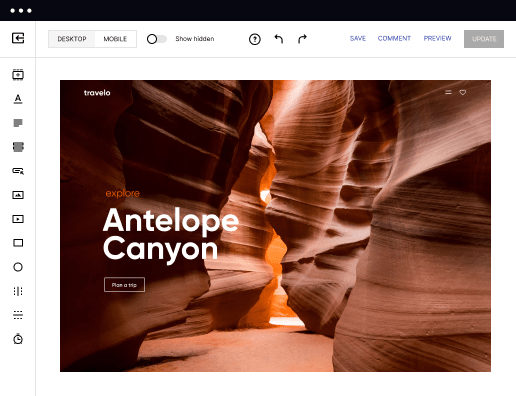
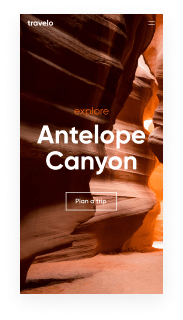
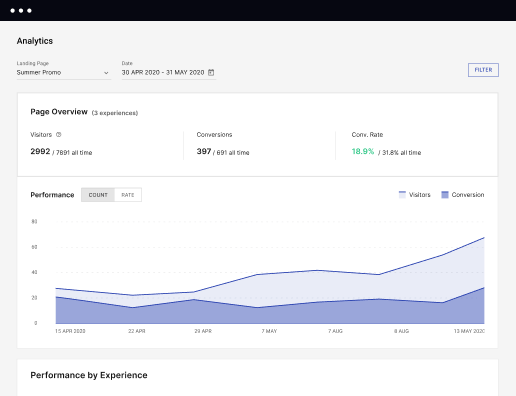
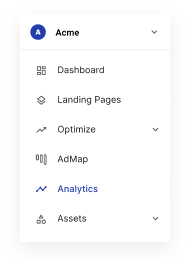
Easy to build without coding
With the intuitive drag-and-drop builder, anyone on your team can create high-converting pages without any knowledge of code or design. Make enhancements to your landing page with custom widgets using Javascript, HTML/CSS, or third-party scripts.
Multiple layouts for any industry and goal
Select from 500+ landing page layouts built to boost conversions across industry-specific scenarios. Customize them by adjusting fonts, adding images, and generating on-brand content with the AI assistant. Quickly scale with Instablocks® and Global Blocks that you can save, reuse, and update globally.
Loads fast and looks polished on any device
Every template is responsive, which means they present professionally on any device and load blazingly fast with our Thor Render Engine. You can also power them up with Google AMP technology to deliver an unparalleled mobile experience and drive higher conversions.
Robust analytics & experimentation
Get real-time updates and reporting across all your devices, showing the number of visitors, conversions, cost-per-visitor, and cost-per-lead. Launch AI-powered experiments, run A/B tests, and use heatmaps to analyze user behavior, then optimize your landing page to maximize conversions.
All the features you need to build lead-generating landing pages
Explore more featuresLearn how to build top-performing landing pages for any goal
FAQs
Leading the way in building high-performing landing pages





Maximize Your ROI with Instapage Landing Pages
In a competitive digital landscape, optimizing your marketing strategies is crucial. Instapage offers powerful landing page solutions that cater specifically to marketers aiming for high conversion rates. With over 100 high-converting templates and built-in optimization features, launching effective campaigns has never been easier.
Why Choose Instapage for Your Landing Pages?
Instapage provides marketing professionals with an all-in-one platform to achieve their goals. Built with both efficiency and effectiveness in mind, this platform allows users to create, optimize, and scale landing pages without the need for technical expertise. Instapage’s value proposition lies in its intuitive tools that facilitate streamlined processes for marketers across various sectors.
- User-friendly interface: Instapage offers a drag-and-drop builder that simplifies the creation of complex landing pages.
- Comprehensive template library: With access to 100+ templates, users can effortlessly launch pages tailored to their audience.
- Advanced personalization features: Customize experiences for different audience segments, enhancing engagement and conversion rates.
Step 1: Create Your Landing Page
To kick off your journey with Instapage, follow these simple steps to create your landing page:
Step 2: Optimize for Conversions
Optimization is key to achieving higher conversions. Utilize these actions to enhance your landing page performance:
- Conduct A/B testing: Experiment with different page versions to ascertain what resonates with your audience.
- Use heatmaps: Understand user behavior on your landing pages to strategize layout improvements.
- Analyze data: Utilize the integrated analytics dashboard to track performance metrics and make data-driven decisions.
Step 3: Collaborate with Your Team
Collaboration fosters faster production cycles. Here’s how to effectively collaborate on Instapage:
- Instant feedback: Utilize real-time feedback tools to keep communication channels open with your team.
- Secure sharing: Easily share pages with stakeholders while maintaining controlled access to sensitive information.
- Real-time editing: Make changes live during discussions to streamline decision-making and enhance productivity.
By following these steps, you can leverage Instapage's robust features effectively to enhance your marketing efforts.
Ready to transform your marketing campaigns? Sign up for Instapage today and turn your landing pages into effective sales tools!
People also ask about Angular.js optimized feed page template
Unleashing the Power of AngularJS in Feed Page Development
The evolution of web technologies
The world of web development has seen significant shifts in technology and user expectations over the years. One of the pivotal developments in this landscape has been the introduction of AngularJS, which emerged in 2010, crafted by Misko Hevery and the team at Google. Rooted in the principles of component-based architecture and declarative programming, AngularJS provided developers with a robust framework for building dynamic web applications, setting the stage for how frontend development would evolve.
AngularJS laid the foundation for future frameworks and libraries by incorporating features like two-way data binding and dependency injection. With the advent of frameworks such as Angular, React, and Vue.js, the core principles of AngularJS informed subsequent innovations, making them more efficient and developer-friendly. These advancements have propelled web development into an era where deliverability and user engagement are paramount.
The role of SPAs in modern web development
Single Page Applications (SPAs) have transformed the web user experience dramatically. By loading content dynamically and rendering views without refreshing the browser, SPAs offer seamless and swift interactions that users have come to expect. This shift has prompted developers to adopt frameworks like AngularJS, which excel at managing front-end functionality and deliver optimal user experiences by reducing loading times.
In this ecosystem, optimized feed pages play an essential role, serving as the primary conduit for users to consume ever-growing amounts of content efficiently. SPAs ensure that these feed pages can adapt and respond to user actions instantly, creating an engaging environment that drives traffic and extends user sessions. The alignment of AngularJS with the principles of SPAs positions it as a prime choice for developers aiming to build effective feed pages.
The need for optimized feed pages
Optimized feed pages are essential to delivering a smooth user experience on platforms where content dynamically updates and evolves. Key features of an optimized feed page template include rapid content loading ability, intuitive navigation, and minimal overhead to reduce latency. Users prefer interfaces where content is readily accessible, and their actions feel responsive, making optimization pivotal in enhancing user satisfaction and retention.
However, traditional feed designs often fall short due to long loading times, rigid layouts, and overwhelming amounts of information displayed simultaneously. These common issues lead to disorganized user experiences characterized by frustration and disengagement. Implementing an AngularJS optimized feed page addresses these gaps by utilizing its robust features to present content efficiently while ensuring users can easily find and interact with what they need. The result is a well-structured, visually appealing, and engaging platform that attracts and retains visitors.
Core features of an AngularJS optimized feed page template
A hallmark of AngularJS's functionality is its data binding capabilities, which is a crucial aspect of an optimized feed page template. With two-way data binding, any changes made to the UI are reflected in the underlying model and vice versa, ensuring that the displayed content is always current. This capability makes it easy for developers to manage dynamic content, presenting users with up-to-date information without the constant need to refresh the page.
Moreover, AngularJS’s directive system significantly enhances user experience. By creating reusable components with custom directives, developers can encapsulate HTML and behavior, fostering a modular approach to application development. This ease of creating components not only accelerates the development process but also encourages code reusability and uniformity across the application's feed structure, providing a consistent experience for users.
Services and factories further streamline data management in AngularJS applications. With well-structured services, developers can store and manage application-wide data efficiently, facilitating smoother interaction with APIs and databases while avoiding code duplication. This organization ensures that the feed page performs well under both low and high loads, allowing for optimal user experiences regardless of the level of interaction.
Architectural insights and best practices
Organizing an AngularJS application effectively is vital for scalability and maintainability. Developers are encouraged to adopt a modular approach in structuring their application, which can include dividing the application into sections based on functionality or features. A suggested folder structure might include directories such as 'controllers,' 'services,' 'directives,' and 'views,' each clearly defined to enhance navigability within the project.
Implementing pagination and infinite scroll is crucial in an optimized feed page experience. Techniques like lazy loading content enable developers to load data in chunks, presenting a smoother browsing experience for users. With pagination, users can quickly navigate through content without feeling overwhelmed, while infinite scroll allows them to engage continuously with the feed, which can increase interaction time—a prime goal for marketing strategies.
User-centric interfaces can be crafted using AngularJS, ensuring that layouts are responsive and fluid. By utilizing CSS frameworks alongside AngularJS utilities, developers can create designs that cater to varying screen sizes while maintaining accessibility standards. This commitment to functionality not only aligns with brand principles but also fosters an inclusive environment for all users, matching Instapage’s objective of enhancing conversion rates and brand loyalty.
The role of teams in developing optimized feed pages
Collaboration is at the heart of effective feed page development. Utilizing agile methodologies promotes a team dynamic that can adapt and evolve through iterations based on user feedback and performance data. Tools like JIRA and Slack facilitate seamless communication, enabling team members to share insights, troubleshoot issues, and execute tasks with clarity and focus. This interconnectedness is fundamental in ensuring a well-orchestrated development process that reflects user needs and market trends.
Engaging with community resources also plays a significant role in optimizing feed pages. The vast array of open-source contributions available through platforms like GitHub provides developers with templates, extensions, and libraries that can enhance their projects. By actively participating in AngularJS communities, developers can stay abreast of the latest updates, best practices, and case studies, ensuring their feed pages are competitive and innovative.
Practical implementation scenarios
AngularJS optimized feed pages are being employed across various industries, showcasing their versatile applications. For instance, eCommerce platforms utilize these pages to dynamically present product listings, often categorized by user preferences or previous interactions, enhancing personalization that leads to increased conversions. News outlets exploit AngularJS to deliver real-time content updates, ensuring their audiences stay informed without delay, thereby fostering trust and loyalty.
Within the realm of social media platforms, optimized feed pages play a critical role in user engagement strategies. By leveraging algorithms that promote content based on user behavior and interests, platforms can create feeds that feel relevant and engaging. These personalized experiences are enhanced when user feedback loops are implemented, allowing developers to iterate and modify the feed based on analytics data and community inputs, continuously improving the service.
Overcoming common challenges
As businesses grow, so do their user bases, leading to unique challenges in traffic management and application performance. Implementing scalable solutions becomes crucial in this context. Techniques such as caching frequently accessed data and optimizing API calls can significantly reduce load times and enhance user experience during peak traffic periods. By utilizing tools like Redis for caching and server-side processing, developers can mitigate slow load speeds, preserving engagement even with fluctuating user loads.
In addition, security concerns must not be overlooked in AngularJS application development. Emphasizing best practices, such as data sanitization and employing security libraries, is essential for protecting user data against common threats. Additionally, keeping AngularJS updated with the latest patches and security fixes is vital. Regular vulnerability assessments also strengthen the overall integrity of the application, ensuring that user trust remains intact.
Future directions in AngularJS and feed page development
The future of AngularJS and its application in optimized feed page development is poised to be exciting with the integration of emerging technologies like AI and machine learning. These technologies are redefining content recommendations and personalizing user experiences within feed pages, thereby enhancing engagement. By analyzing user behavior patterns and preferences, businesses can create tailored content that resonates with their audience, driving conversions and satisfaction.
Additionally, the growth of Progressive Web Applications (PWAs) opens new avenues for optimizing feed pages in AngularJS. PWAs ensure fast, reliable experiences, enhancing performance even in areas with poor network connectivity. This approach aligns with the ongoing trend toward mobile-first development, allowing marketers to deliver engaging landing pages that convert visitors effectively. Communities and collaborations in this space will continue to evolve, fueling innovations through shared knowledge and peer support.
Conclusion of key takeaways
Optimized AngularJS feed pages can significantly enhance user satisfaction, drive performance, and scalability, particularly when executed thoughtfully. By employing the strategies discussed throughout this article, businesses can create feeds that are not only functional but also visually appealing and engaging. Implementing best practices ensures that these applications remain resilient against challenges posed by user growth and technological changes.
In this fast-evolving digital landscape, the emphasis on ongoing learning and adaptation is vital. Developers and marketers must remain committed to innovation, consistently refining their technological approaches to meet the changing expectations of their users and capitalize on new marketing opportunities. The journey of optimizing AngularJS feed pages is not just a technical endeavor; it is a pathway to building trust and loyalty among users, solidifying a brand’s reputation in an increasingly competitive space.
Ready to skyrocket conversions?
Supercharge your ad campaigns with high-performing landing pages
Get started